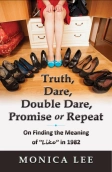When I was growing up—in Minnesota, nearly 40 years ago—St. Patrick’s Day meant wearing green or risk getting pinched. I remember one year in high school—probably about ninth grade—I was late for school because I couldn’t find something both green and flattering to wear on St. Patrick’s Day. And I really didn’t want to get pinched.
Finally, I decided to wear a necklace with light green beads. Weak, very weak showing on St. Patrick’s Day. I probably got pinched anyway.
About a decade ago, I moved to Illinois and I was astounded by what St. Patrick’s Day meant to people. Sure, some of the folks here wear green and Chicagoans dye the Chicago River green, but if you’re observing this patron saint’s day properly in Chicagoland, you better be toasting with a foamy green beer and a plate of corned beef.

Ah, green, a reminder of spring. Not beer.
Just about every restaurant around here has a St. Patrick’s Day special that includes corned beef and sometimes cabbage or soda bread. Maybe Chicago is particularly merry about this holiday, but I think this secular fascination with all things green on St. Patrick’s Day has spread across the country. I blame lazy marketers who run every great religious holiday straight into the ground by starting too early, going too literal and turning it into a secular excuse to drink alcohol.
If it’s Irish, it has to be green? Really? St. Patrick wasn’t even Irish. He was born in England and brought by pirates to Ireland as a slave. He eventually escaped, found God and returned to Ireland as a missionary.
When we should be remembering his courage and benevolence, we’re honoring St. Patrick by wearing dorky four-leaf-clover hats and complaining about how gassy cabbage makes us.
Most of us wouldn’t know even his first name without the green beer. All we Americans need to twist the meaning of a solemn holiday is liquor, a three-day weekend and fireworks (see: Independence Day). Because newspapers/magazines/bars/TV newscasters need a hook to get our attention, we’re all celebrating a holiday that means nothing to most of us because it’s an excuse to get drunk. Yes, I get curmudgeonly about it.
If you like corned beef, you can eat it any day of the year. And if you like green beer or Irish coffee, you should examine your excuses for imbibing at 10 a.m. You may have a problem that can only be solved with a 12-step program.
Wikipedia now defines St. Patrick’s Day as a cultural and religious holiday honoring Irish heritage. OK, this is nice for the Irish, if not St. Patrick, but one has to dig pretty deep in Google results to find holidays honoring Nigerian or Japanese heritage.
Since I am a little bit Scotch-Irish (which means I could be Irish but it also means I could be Scottish), I am wearing green today in honor of St. Patrick, not St. Patrick’s Day (and also, to guard against getting pinched). And I might enjoy some corned beef because it’s delicious and plentiful. I’m passing on the green beer (though I might quaff an amber one). My advice? You do you.
I’m also sharing a little bit of St. Patrick’s Breastplate, a popular prayer attributed to the patron saint which was shared in church today. This is the most secular bit of it, and it’s quite beautiful whether you believe in St. Patrick or God or green beer:
I arise today, through
The strength of heaven,
The light of the sun,
The radiance of the moon,
The splendor of fire,
The speed of lightning,
The swiftness of wind,
The depth of the sea,
The stability of the earth,
The firmness of rock.
Thank you, St. Patrick, for inspiring today’s blog post. God rest your eternal soul.









